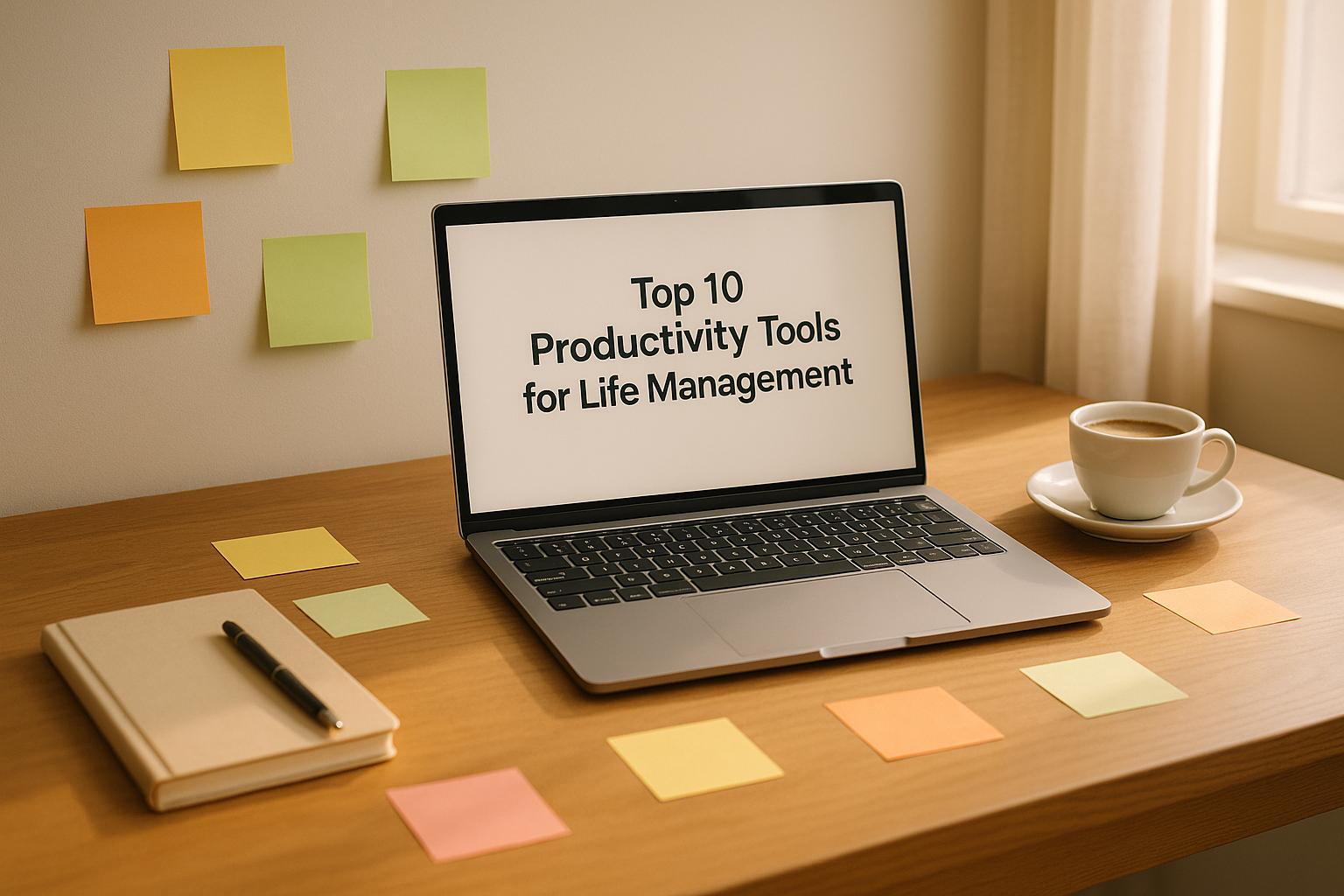
Top 10 Productivity Tools for Life Management
In today’s busy world, staying organized and productive can be a challenge. Luckily, there are plenty of tools designed to help you manage tasks, track goals, and streamline your daily life. Here’s a quick look at 10 productivity tools that can make life easier:
- malife: Organizes tasks using Life Areas and a Kanban-style workflow. Features voice capture and prioritization tools.
- Todoist: Simple task manager with natural language input and a gamified productivity system.
- Trello: Visual Kanban boards for task tracking and team collaboration.
- Notion: A flexible workspace combining notes, databases, and project management.
- Evernote: A note-taking app with task management, web clipping, and powerful search.
- Google Calendar: Combines scheduling and task management with smart reminders.
- RescueTime: Tracks your activity to provide insights into time management.
- Focus@Will: Uses music designed to improve focus and reduce distractions.
- Bear: A writing and note-taking app with Markdown support and nested tags.
- Forest: A gamified focus tool that rewards you with virtual trees for staying on task.
These tools cater to different needs, from managing tasks and schedules to improving focus and organization. Whether you prefer structured workflows or creative approaches, there’s something here for everyone.
Quick Comparison
| Tool | Best For | Starting Price | Key Features |
|---|---|---|---|
| malife | Life management with GTD | Free | Life Areas, voice capture, prioritization matrix |
| Todoist | Task management | Free/$4/month | Natural language input, productivity tracking |
| Trello | Visual project tracking | Free/$5/month | Kanban boards, team collaboration |
| Notion | All-in-one workspace | Free/$8/month | Notes, databases, custom dashboards |
| Evernote | Note-taking and organization | Free/$7.99/month | Web clipping, document scanning, smart search |
| Google Calendar | Scheduling and reminders | Free | Calendar events, task sync, cross-platform |
| RescueTime | Time tracking | Free/$12/month | Activity insights, focus alerts |
| Focus@Will | Concentration improvement | $8.99/month | Music for focus, personalized soundscapes |
| Bear | Writing and note organization | Free/$1.49/month | Markdown, nested tags, cross-note linking |
| Forest | Gamified focus | $3.99 (one-time) | Virtual trees, distraction blocking |
Each tool offers unique features. Start by identifying your specific needs - whether it’s task management, time tracking, or focus improvement - and choose the tool that aligns with your goals.
1. malife

malife is a life management platform inspired by David Allen's Getting Things Done methodology, designed to simplify task handling and long-term planning.
Task Organization and Management
malife takes a unique approach by categorizing your tasks using Life Areas and presenting them in a clear Kanban-style workflow. With dedicated Today and Next views, you can easily track both tasks and projects across various aspects of life - whether it's your career, health, relationships, or personal goals. This setup ensures everything stays organized and prevents tasks from getting lost in the shuffle.
One of its standout features is the voice capture tool. You can simply speak your thoughts, and the app will automatically fill in the task details, making it effortless to capture ideas as they arise.
Goal Tracking and Prioritization
The platform incorporates an Impact vs. Effort matrix to help you prioritize tasks. By evaluating each task's potential impact and the effort required, malife enables smarter decision-making and helps you focus on meaningful progress. It also supports recurring tasks for habit-building and includes a journaling feature for capturing insights and reflections. These tools are seamlessly integrated, ensuring smooth functionality across malife's ecosystem.
Integration with Other Tools
malife works as a standalone solution, keeping your data synchronized across devices through its cross-platform availability. While already compatible with various platforms, malife is expanding to include macOS and Android versions, ensuring accessibility no matter what device you use. It also offers handy features like quick reminders (+10 minutes, +1 hour, +1 day), customizable repeat patterns, and simple rescheduling options.
Key Features for Productivity
The Focus Timer is a powerful tool that helps you stay engaged during work sessions, promoting deep focus and productivity. Combined with precise scheduling options for due dates and times, malife supports a balanced approach to managing tasks and projects, encouraging a holistic view of all areas of your life.
2. Todoist
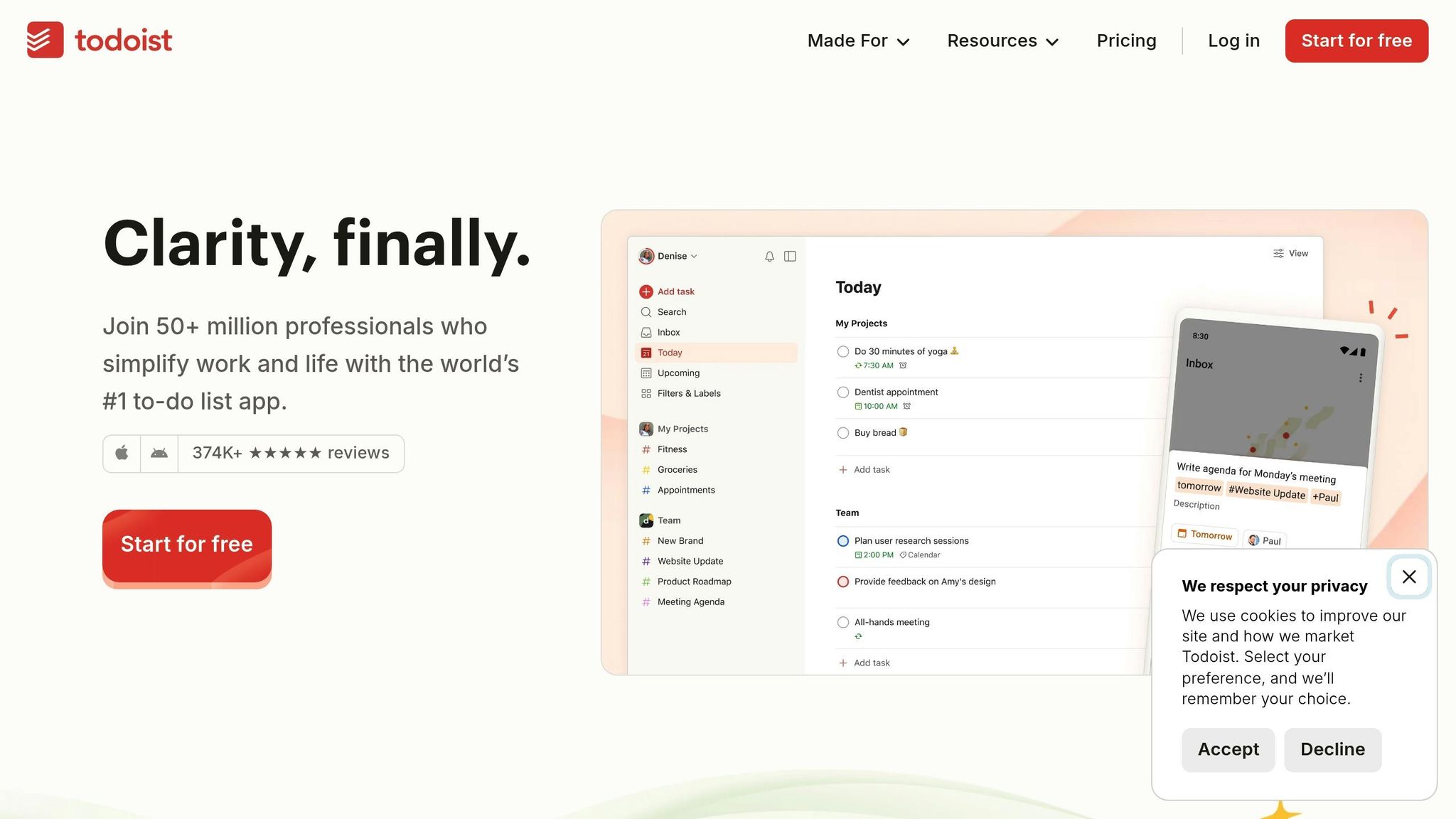
Todoist is a powerful tool designed to turn your to-do lists into organized, actionable workflows. With its focus on clear structure and smart prioritization, it helps you stay on top of tasks across all areas of your life.
Task Organization and Management
Todoist uses a project-based approach to keep your tasks neatly categorized. You can create separate projects for work, personal goals, home tasks, or family activities. Its natural language processing makes adding tasks quick and intuitive - simply type something like "Call dentist tomorrow at 2pm", and Todoist will automatically set the due date for you.
With features like labels, filters, and sub-tasks, Todoist makes it easy to break projects into smaller, more manageable steps. You can tag tasks with labels such as @phone, @computer, or @errands, making it simple to group and view tasks that require similar resources or locations.
Goal Tracking and Prioritization
Todoist doesn't just help you organize - it also keeps you focused on what matters most. Its four-level priority system (P1–P4) ensures urgent tasks stand out, with high-priority items highlighted in red. For an extra boost of motivation, the Karma system gamifies productivity by tracking your task completion streaks and daily goals, rewarding you with visual progress updates.
The app also supports weekly and monthly goal-setting, allowing you to set specific targets for completed tasks. Plus, its productivity trends feature provides insights into your habits, showing when you're most productive so you can schedule important work during peak focus times.
Integration with Other Tools
Todoist works seamlessly with a wide range of apps, enhancing your workflow. It integrates with over 60 applications, including Gmail, Slack, Google Calendar, and Dropbox. For instance, you can turn emails into tasks directly from your Gmail inbox, or sync deadlines with your calendar to ensure everything stays aligned. This two-way sync means your calendar reflects task details, while Todoist keeps track of deadlines.
Key Features for Productivity Improvement
Todoist also excels at handling recurring tasks and team collaboration. Templates make it easy to recreate workflows for ongoing projects, whether you're planning vacations, organizing team meetings, or conducting monthly reviews. Collaboration tools let you share projects, assign tasks, and communicate through comments, making it perfect for group efforts.
Additionally, location-based reminders use your phone's GPS to notify you when you're near a specific place - ideal for remembering errands like picking up dry cleaning or grabbing groceries. The smart scheduling feature suggests due dates based on your workload, helping you plan more effectively.
With its combination of organization, prioritization, and seamless integrations, Todoist is a versatile tool for staying productive in every aspect of your life.
3. Trello
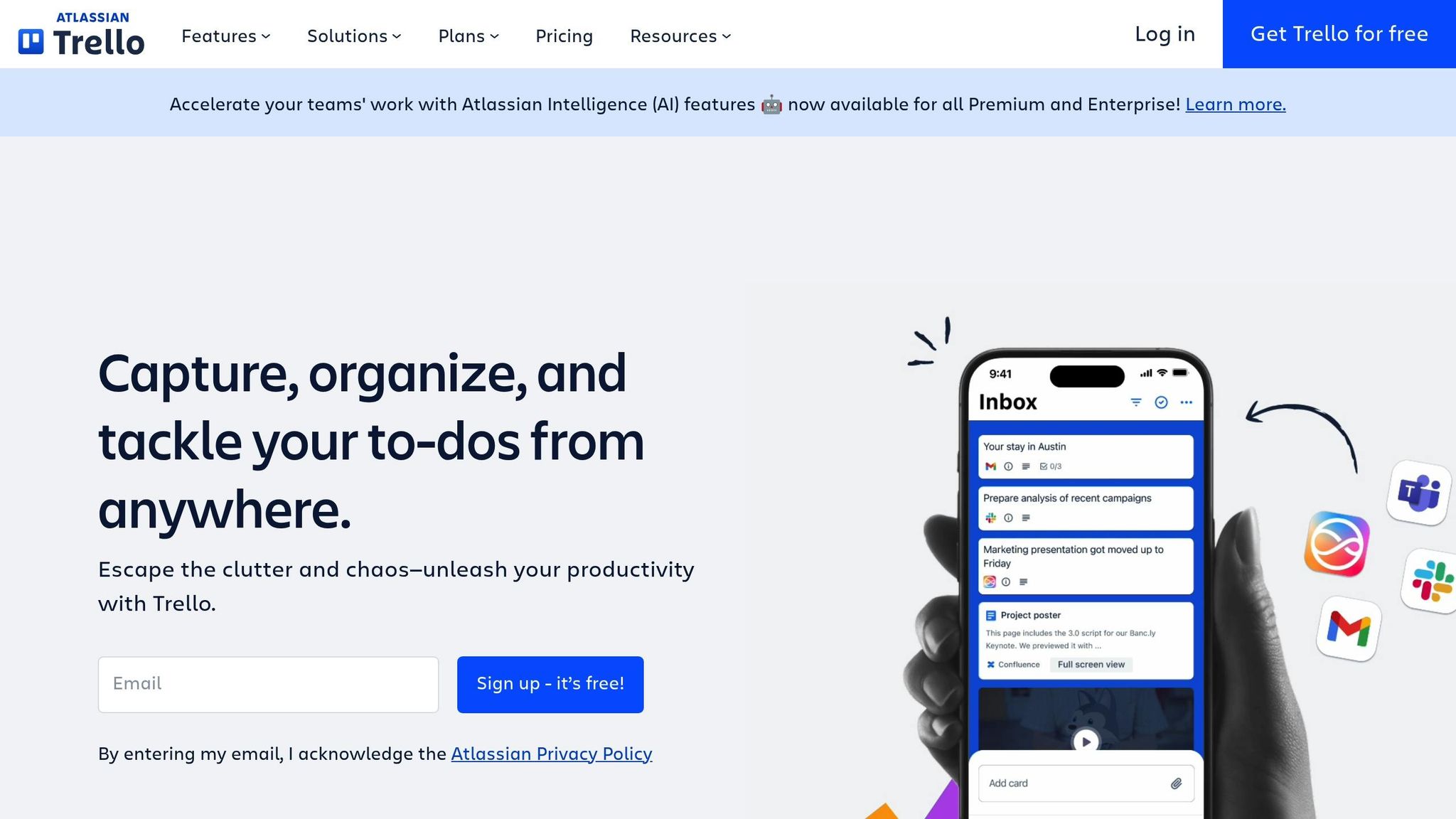
Trello provides a visually intuitive way to manage tasks and projects using boards, lists, and cards. This Kanban-style system helps you keep track of everything from personal goals to work deadlines and daily to-dos.
Task Organization and Management
Trello makes organizing tasks simple and effective. Boards act as dedicated spaces for different areas of your life - think career goals, personal hobbies, or family plans. Within each board, lists represent workflow stages, like the classic "To Do, Doing, Done", or even custom categories based on priority.
Each card represents a specific task. Cards can include details like due dates, checklists, file attachments, and color-coded labels for quick sorting. Need more structure? The Custom Fields feature lets you add tailored information to suit your process.
The Trello Inbox is a handy tool for capturing tasks from various sources. Whether it's a voice note, an email, or a Slack message, Atlassian Intelligence converts them into actionable items, keeping everything centralized.
Goal Tracking and Prioritization
Trello helps you juggle long-term goals and daily priorities. Its labels system uses colors (like red for urgent tasks) to highlight what matters most. Want to break big goals into smaller steps? Advanced checklists within cards let you assign deadlines to individual tasks, making even complex projects manageable.
With Calendar and Timeline Views, you can see your tasks laid out as a visual schedule, making it easier to spot overlapping deadlines or bottlenecks. Card Mirroring ensures that critical tasks appear on multiple boards - so, for instance, a quarterly goal can show up on both your monthly and weekly boards, with updates syncing automatically. These tools integrate seamlessly with Trello's other features, making it easier to stay on top of your workflow.
Integration with Other Tools
Trello connects with over 200 apps through its Power-Ups system, turning it into a central hub for your work. For example, it integrates with Google Calendar and will soon support Microsoft Outlook Calendar through Trello Planner, allowing you to view your tasks alongside your schedule. You can even drag and drop tasks directly onto your calendar to block out focused work time.
Smart Links make it easy to manage external resources. Paste a URL into a Trello card, and it becomes a rich preview. You can view, edit, and collaborate on linked files like Google Docs or Figma designs without leaving Trello. This feature is a game-changer, especially considering that workers spend roughly 9% of their day switching between tabs and apps.
Key Features for Productivity Improvement
Trello’s automation tools take care of repetitive tasks, no coding required. You can set up rules to automatically move completed cards, assign due dates, or notify team members - freeing you up to focus on what really matters.
The platform also offers templates for popular productivity methods, such as Daily Task Management, Weekly Planners, Annual Life Goals, and Getting Things Done (GTD). These templates give you a structured starting point, which you can then adapt to fit your needs.
Research supports the benefits of organized task management: 75% of organizations report seeing results with Trello within 30 days, and 81% of users choose it for its ease of use.
Trello’s pricing is flexible. It offers a free plan for up to 10 collaborators, a Standard plan at $5.00 per user/month (billed annually), Premium at $10.00 per user/month with AI features, and Enterprise at $17.50 per user/month.
4. Notion
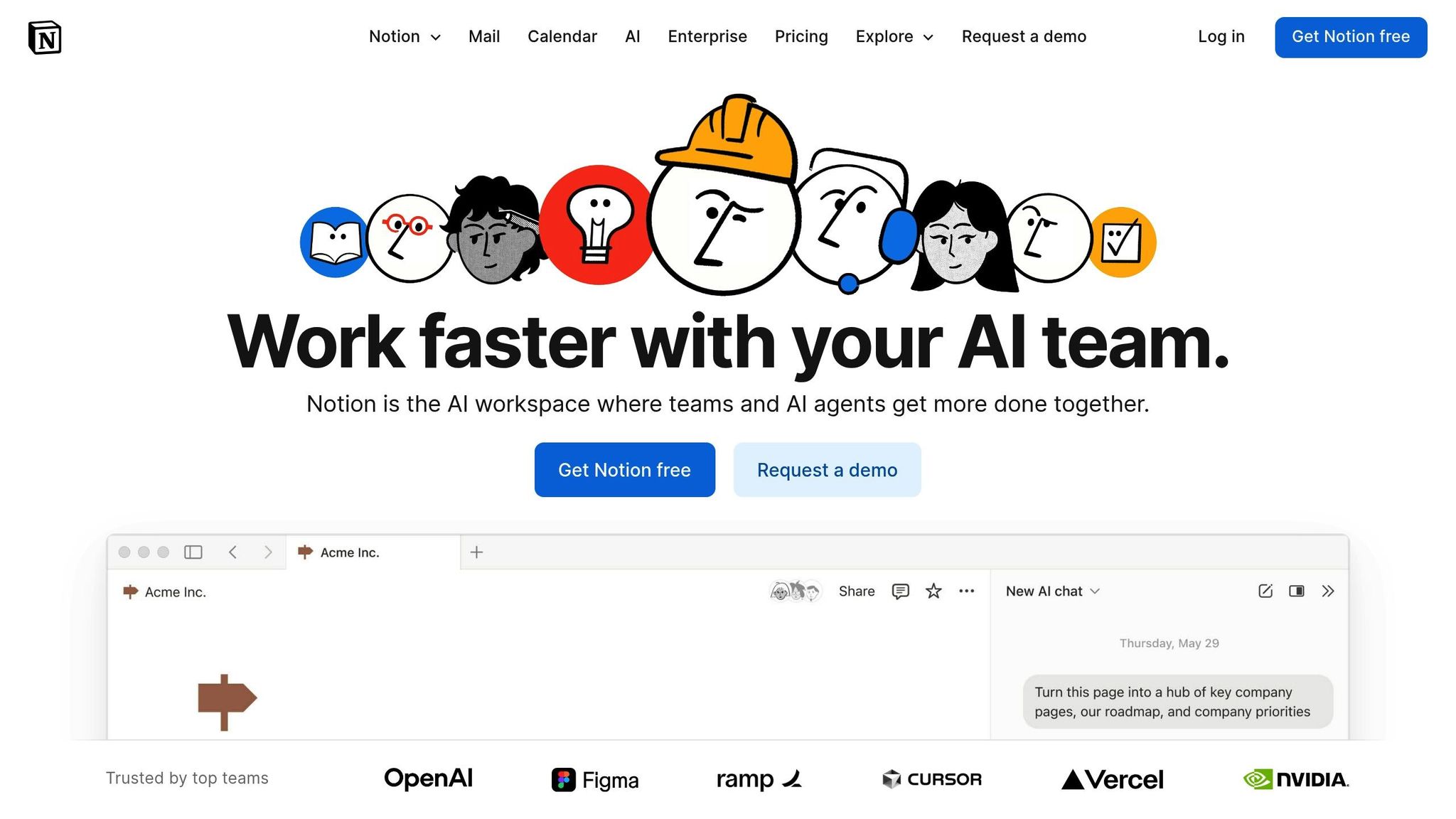
Notion brings together notes, databases, wikis, and project management into one seamless workspace. Its flexibility makes it a standout tool for organizing both personal and professional life. You can tailor it to fit your unique needs, creating systems that work the way you do.
Task Organization and Management
Notion’s database system is a powerhouse for organizing tasks. It allows you to store and connect properties like priority, categories, deadlines, status, and related projects. These databases can be viewed in various formats - like lists, Kanban boards, calendars, or galleries - depending on how you prefer to work.
For example, templates such as the Getting Things Done (GTD) setup use linked databases for projects, tasks, and responsibilities. These automatically update as tasks are completed. With relation properties, you can link daily tasks to larger projects or even long-term goals, whether they’re related to your career, health, or other areas of life.
Goal Tracking and Prioritization
Notion shines when it comes to managing goals. Its nested page structure and database relationships make it easy to break down big goals into smaller, actionable steps. You can organize annual goals into quarterly objectives, monthly milestones, and weekly tasks. Rollup properties even calculate your progress automatically, giving you a clear picture of how far you’ve come.
Want to prioritize smarter? Notion’s formula system lets you create custom scoring systems based on urgency, importance, effort, or potential impact. This takes the guesswork out of deciding what to tackle first. Visual tools like progress bars and dashboards make it easy to track your achievements and identify areas that need more focus.
Integration with Other Tools
Notion’s integration capabilities make it even more versatile. Using its API or Zapier, you can connect it to popular productivity tools. For instance, you can automatically create tasks from emails, calendar events, or form submissions. If someone books a meeting through a scheduling tool, Notion can instantly generate a preparation task with all the relevant details.
The web clipper is another handy feature - it lets you save articles, research, or inspiration directly into your workspace. Meanwhile, the AI writing assistant can help with tasks like generating content, summarizing meeting notes, or breaking down complex projects into manageable steps. And if you’re switching from other tools like Trello, Google Docs, or CSV files, Notion’s import/export features make the transition smooth while keeping your existing structure intact.
By combining these integrations with automation, Notion simplifies workflows and eliminates repetitive tasks, saving you valuable time.
Key Features for Productivity Improvement
Notion AI takes productivity to the next level by handling tasks like summarizing meetings, extracting action items, and generating content. Template buttons allow you to quickly create new project setups, daily review formats, or habit trackers with just one click.
Collaboration is seamless too. You can share pages or databases with family, teammates, or accountability partners for real-time editing and better coordination.
Notion offers a free plan with essential features for personal use, alongside paid plans that include perks like unlimited file uploads, advanced permissions, and expanded version history. For the latest pricing and features, it’s best to check Notion’s official website.
5. Evernote

Evernote simplifies the way you collect, organize, and access information across all areas of your life. Think of it as your digital memory, storing everything from meeting notes and research materials to personal journals and creative ideas. It’s designed to make even the most scattered information easy to find and use.
Task Organization and Management
Evernote combines note-taking with powerful task management tools to help you stay on top of your responsibilities. You can create separate notebooks for different areas of your life - like work, personal projects, or health goals - and use checkboxes within notes to turn items into actionable tasks.
The Tasks feature takes it a step further by allowing you to assign due dates, set reminders, and flag important to-dos. Everything syncs automatically across your devices, so you can add a grocery list on your phone and review work deadlines on your laptop without missing a beat. A centralized dashboard lets you filter tasks by due date, notebook, or priority level, keeping everything organized.
For example, instead of just jotting down “prepare presentation,” you can embed that task in a note containing your research, outline, and references. This setup eliminates the need to jump between apps, helping you stay focused and efficient.
Integration with Other Tools
Evernote doesn’t just manage tasks - it works seamlessly with other productivity tools to keep your workflow smooth. The Google Calendar integration lets you attach notes directly to calendar events, so all your meeting prep materials are just a click away. Heading into a client call? You can instantly pull up previous notes, project updates, and action items.
The Web Clipper browser extension is another standout feature. It allows you to save articles, PDFs, or entire web pages directly to your notebooks while preserving their formatting. This is perfect for research projects or building a knowledge base. For instance, you can clip a recipe, tag it as "dinner ideas", and easily access it during meal planning.
Evernote also supports email integration, letting you forward important emails directly into your notebooks using unique email addresses. This is ideal for organizing receipts, travel itineraries, or project-related communications. Plus, if you’re using Microsoft Outlook, you can save emails and attachments to Evernote without leaving your inbox.
Key Features for Productivity Improvement
One of Evernote’s standout strengths is its search functionality. It can search not only typed text but also text within images, handwritten notes, and PDFs. Imagine snapping a photo of a whiteboard during a brainstorming session - later, you can search for a keyword and instantly find that note, even among thousands of others.
Templates add structure to recurring tasks like project planning, meeting notes, or weekly reviews. For example, the Daily Planner template includes sections for priorities, schedules, and reflections, helping you maintain consistent habits. You can also customize templates to fit your specific workflows, saving time and effort.
The document scanning feature transforms your phone into a portable scanner. It automatically detects document edges and enhances readability, making it easy to digitize papers, business cards, or handwritten notes. Once scanned, these documents become searchable, seamlessly integrating physical information into your digital system.
To top it off, offline access ensures your most critical notebooks are available even without an internet connection. Whether you’re traveling, commuting, or working in a low-connectivity area, you can rely on Evernote to keep your information accessible. Notes sync automatically as soon as you’re back online, making it a dependable tool for staying organized in any situation.
6. Google Calendar
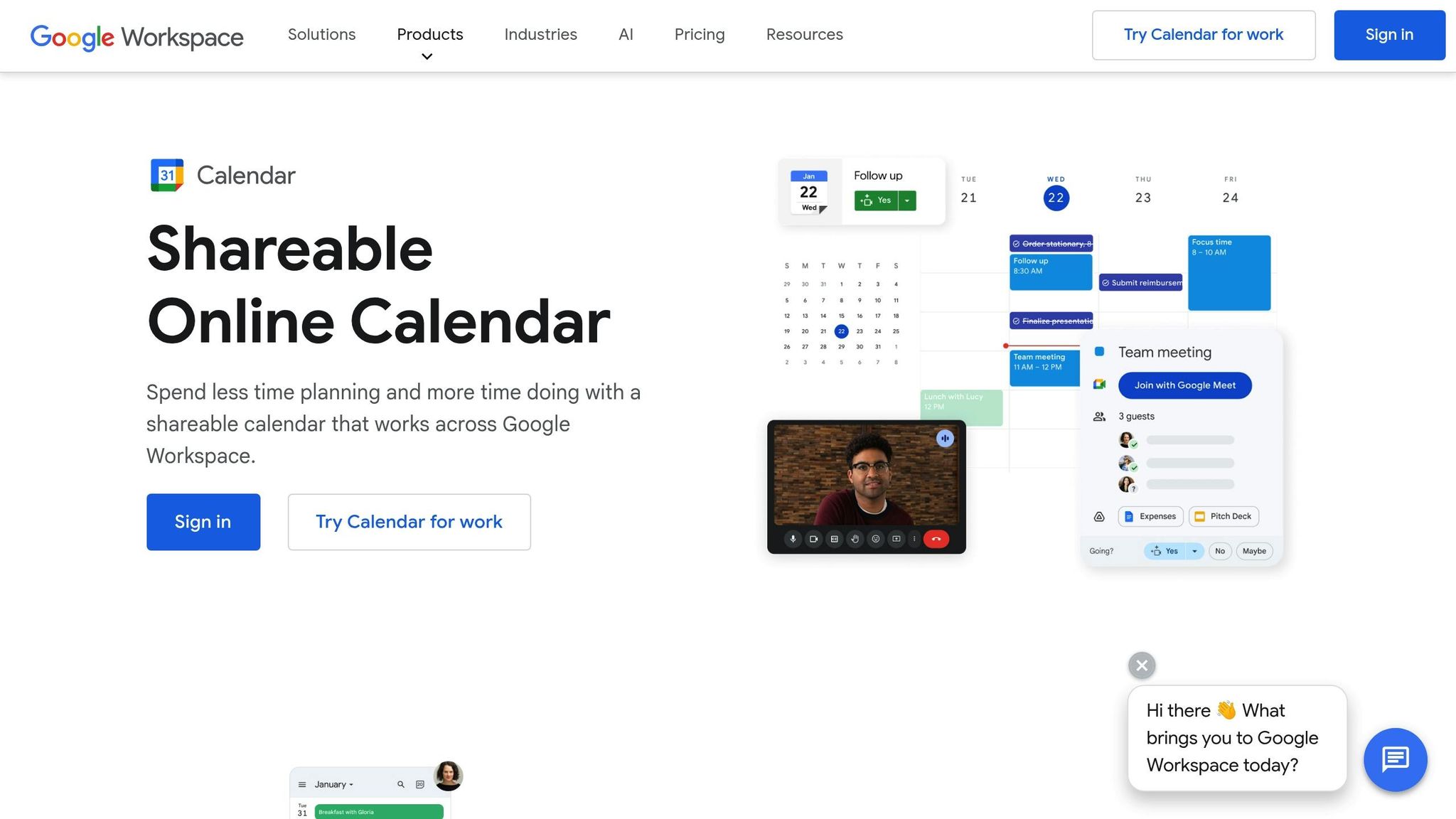
Google Calendar brings together events and tasks, giving you a clear and organized view of your day. By pairing seamlessly with Google Tasks, it makes both short-term scheduling and long-term planning easier.
Task Organization and Management
With Google Calendar's integration with Google Tasks, any task with a set date appears directly on your calendar, keeping everything in one place [11, 12, 17]. You can create separate task lists tailored to different aspects of your life, making it easier to stay organized. For larger projects, you can break them down into smaller, more manageable subtasks [12, 13]. Plus, recurring tasks - whether daily, weekly, monthly, or even yearly - can be set up to automatically populate your calendar, ensuring routine responsibilities are never missed [12, 13, 17].
Integration with Other Tools
Google Calendar syncs effortlessly across all your devices, letting you manage your tasks and schedule no matter where you are [12, 15]. If you’re using a work or school account, the Focus Time feature is a game-changer. It automatically blocks out time for deep, uninterrupted work and even declines meeting invitations during those periods. These integrations make it a powerful tool for staying on top of your schedule.
Key Features for Productivity Improvement
The Schedule View offers a clear, chronological layout of your meetings and tasks, making it easier to plan your day effectively. Smart reminders ensure you never forget important tasks, with notifications popping up across all your devices [12, 16]. And since it’s accessible on multiple devices, your schedule is always just a tap away.
7. RescueTime
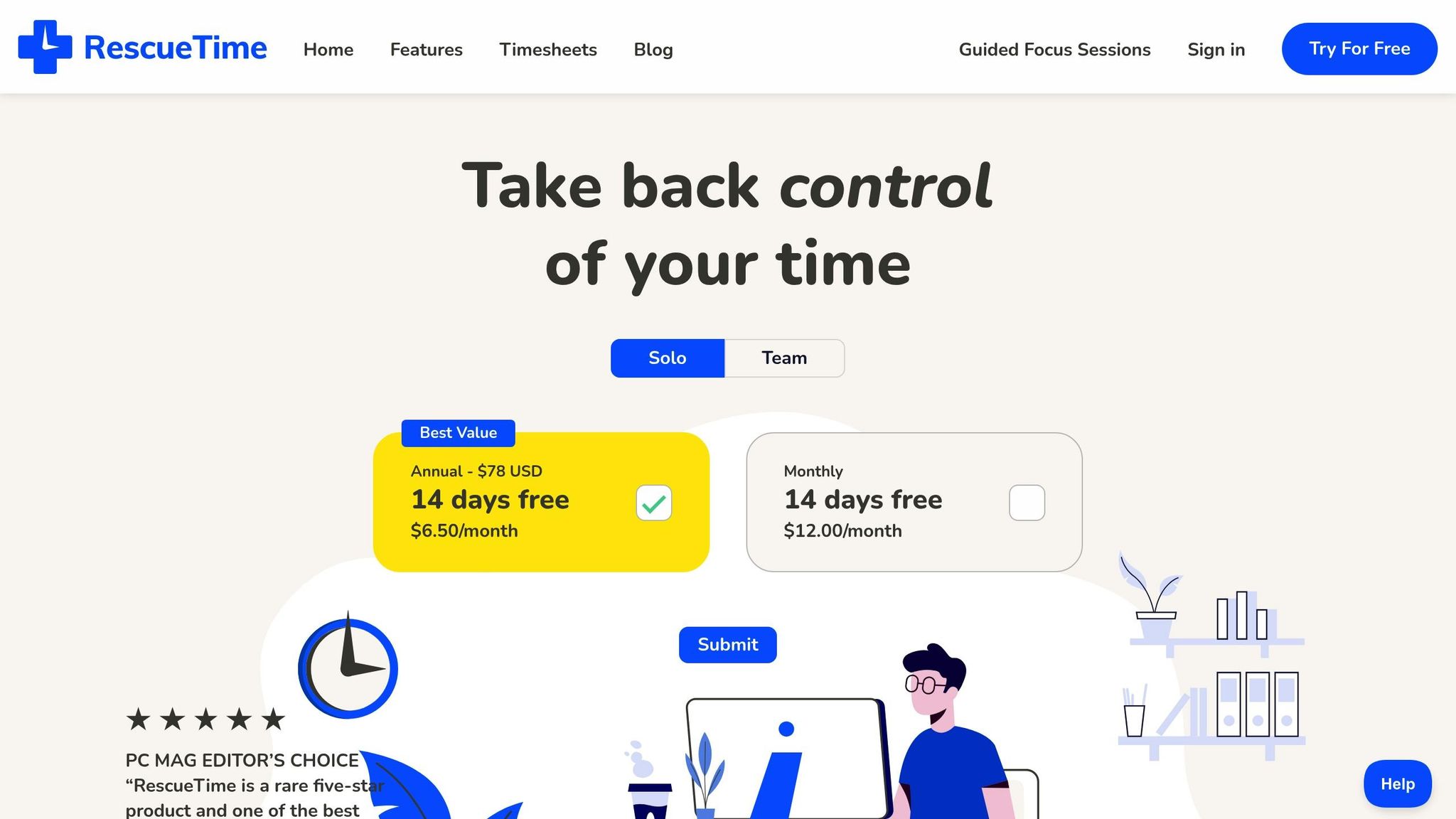
RescueTime works quietly in the background, tracking your activity across devices and websites. It provides a clear picture of how your time is actually spent, compared to how you think you're spending it. This data helps you make smarter decisions about managing your time and goals.
Goal Tracking and Prioritization
With the insights RescueTime provides, you can align your daily actions with your most important goals. The tool categorizes your activities by productivity levels - ranging from "very productive" to "very distracting." You can set daily productivity targets and receive alerts if you spend too much time on unproductive tasks. Its FocusTime feature takes it a step further by blocking distracting websites during your key working hours, ensuring you stay on task. Plus, you can tweak the productivity categories to reflect what being "productive" means for you personally.
Integration with Other Tools
RescueTime works seamlessly across Windows, Mac, iOS, and Android devices. It also integrates with popular calendar apps, automatically tagging scheduled meetings and events as productive time. This ensures your time tracking is both accurate and effortless.
Key Features for Productivity Improvement
The reporting dashboard offers a detailed look at your productivity trends, helping you identify when you're at your best. Weekly email summaries highlight how you've spent your time, including your most productive days and areas where time was wasted. You can even set custom alerts to limit your use of distracting websites or apps, giving you greater control over your focus and efficiency.
8. Focus@Will

Focus@Will is a productivity tool that uses music to help you concentrate better. Backed by neuroscience research, it offers audio tracks specifically designed to reduce distractions and create the ideal environment for focused work.
Accessible on both web and mobile platforms, Focus@Will allows you to take its specially curated soundscapes with you wherever you go. It features a variety of music channels, so you can pick the one that matches your work style - whether you need a calm atmosphere for writing or an upbeat tempo to keep your energy up. This tool works seamlessly alongside other productivity methods to keep your workflow on track.
9. Bear

Bear is a note-taking app designed with writers and organizers in mind. It’s all about simplifying how you capture and manage your ideas, helping you stay organized and productive. With its focus on writing and streamlined organization, Bear seamlessly supports your day-to-day productivity.
One standout feature is its tag-based organization system, which lets you categorize notes naturally. Just add hashtags like #work, #personal, or #project-ideas to keep your notes well-organized without breaking your flow.
Key Features for Boosting Productivity
Bear supports Markdown formatting, making it easy to create polished documents, meeting notes, or project outlines. With simple symbols, you can format text effortlessly - type **bold** for bold text or # for headers. This keeps your focus squarely on your content.
Another handy tool is cross-note linking, which allows you to connect related notes by typing [[. This feature is perfect for building a personal knowledge base, linking meeting notes to projects, or tracking dependencies within larger tasks.
Bear’s search functionality is impressively advanced. You can search not just by keywords but also by tags, modification dates, or creation dates. It’s fast and intuitive, turning searches into a smooth browsing experience instead of a frustrating hunt for information.
Task Management Made Simple
Bear goes beyond note-taking with its basic task management features. Using its checkbox function, you can turn any note into a to-do list, whether you’re tracking daily tasks, planning project steps, or outlining long-term goals.
For more complex projects, Bear’s nested tags are a game-changer. For instance, you can use #work/meetings/weekly to organize team check-ins or #work/projects/launch to group all content related to a product launch. This hierarchy helps you see the big picture while zooming in on specific details when needed.
Seamless Integration with Other Tools
Bear plays nicely with other apps, thanks to its iOS and macOS sharing extensions. You can quickly save articles, emails, or other content directly into Bear for later use. Plus, it supports exports to multiple formats like PDF, HTML, and plain text, making it easy to share your work with teammates who use different tools.
10. Forest
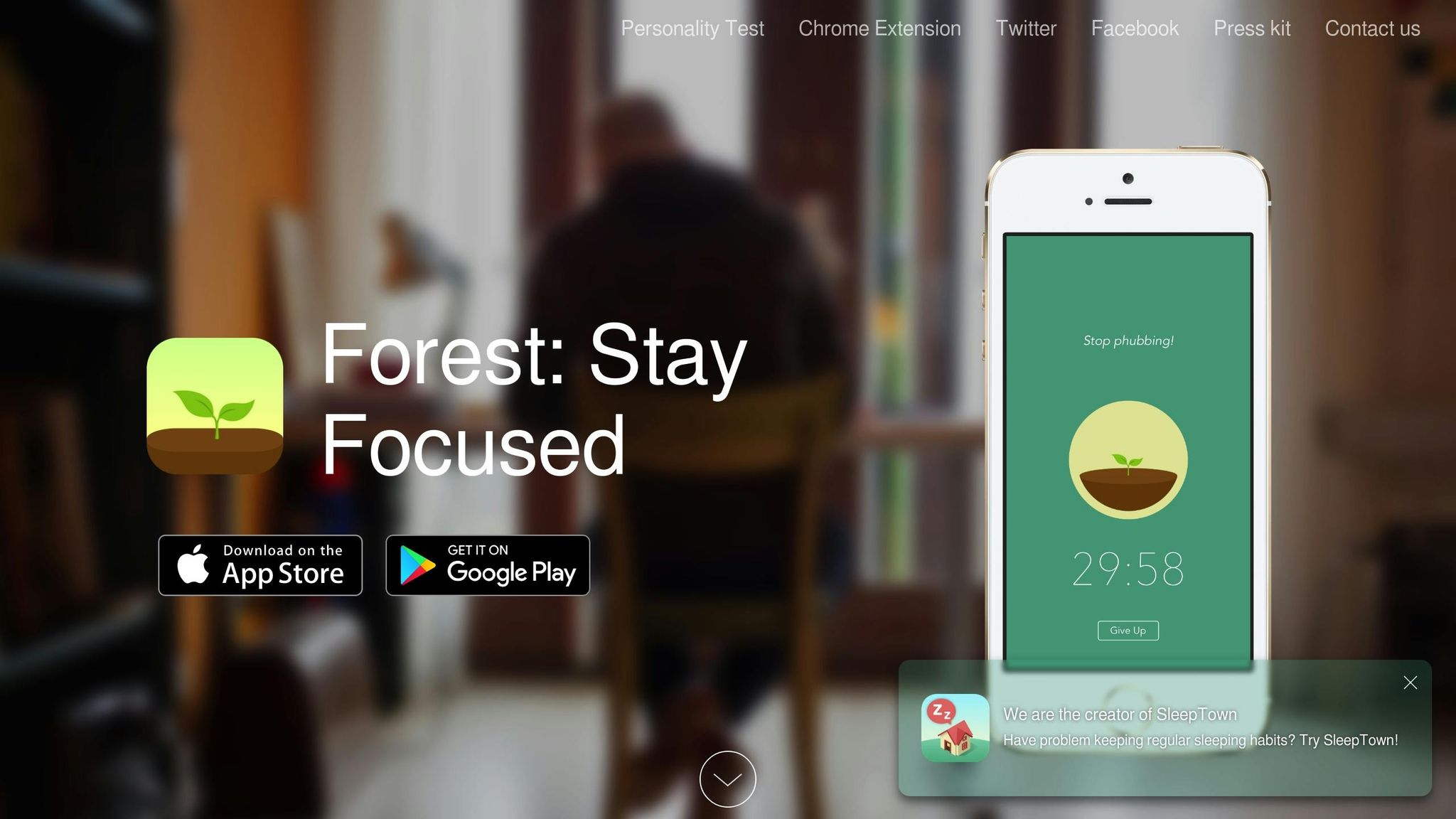
Forest turns staying focused into an engaging game. This app, available on mobile and as a browser extension, helps you concentrate by letting you "grow" virtual trees while working on tasks or spending time with others. The idea is simple: as long as you stay focused, your tree thrives. But if you leave the app to check your phone or get distracted, the tree withers. This visual reward system makes staying on track feel more rewarding - and the consequences of losing focus more immediate.
The app’s gamified approach is a creative way to tackle phone addiction. Over time, as you complete more focus sessions, you’ll grow a vibrant virtual forest - an inspiring visual reminder of your productive efforts.
Forest also syncs your progress across devices, so you can start a session on your phone and pick it up on your tablet or computer without interruption. Its Chrome extension takes it a step further by allowing access to essential sites like Google Docs or email while blocking distractions like social media or streaming platforms. This cross-platform integration ensures you stay focused, no matter where you’re working.
Feature Comparison Table
Finding the right productivity tool depends on your goals, budget, and how you like to organize your workflow. Whether you're drawn to malife's structured Life Areas approach or Forest's gamified focus-building, the table below highlights key features to help you decide.
| Tool | Starting Price | Platforms | Key Strengths | Best For |
|---|---|---|---|---|
| malife | Free | iOS, Web (macOS & Android coming) | Life Areas organization, voice capture, impact/effort prioritization | Holistic life management with GTD methodology |
| Todoist | Free / $4/month | All platforms | Natural language processing, karma system | Task management with motivation tracking |
| Trello | Free / $5/month | All platforms | Visual kanban boards, team collaboration | Project visualization and team workflows |
| Notion | Free / $8/month | All platforms | All-in-one workspace, database functionality | Comprehensive knowledge management |
| Evernote | Free / $7.99/month | All platforms | Web clipping, document scanning | Note-taking and information capture |
| Google Calendar | Free | All platforms | Smart scheduling, Gmail integration | Calendar management and scheduling |
| RescueTime | Free / $12/month | Desktop & mobile | Automatic time tracking, detailed analytics | Time awareness and productivity insights |
| Focus@Will | $8.99/month | All platforms | Neuroscience-based music, focus tracking | Concentration enhancement through audio |
| Bear | Free / $1.49/month | Apple devices only | Markdown support, beautiful design | Writing and note organization on Apple |
| Forest | $3.99 one-time | Mobile & browser | Gamification, phone addiction solution | Focus building through visual rewards |
When comparing these tools, don't just focus on features - think about pricing, platform compatibility, and how each tool fits into your daily routine.
Pricing is a key consideration. Google Calendar is completely free, while premium tools like Focus@Will ($8.99/month) cater to specialized needs. For a more budget-friendly choice, Bear offers premium features at just $1.49/month.
Platform support is another factor. Tools like Todoist, Trello, Notion, and Google Calendar work seamlessly across iOS, Android, Windows, macOS, and web browsers. Meanwhile, malife is currently available on iOS and web, with plans to expand to other platforms soon.
Collaboration features set some tools apart. Trello and Notion are ideal for team environments, offering real-time collaboration and sharing. Google Calendar integrates smoothly into workplace schedules, while tools like Bear and Forest are more suited for individual use.
Your workflow style also plays a role. If you're a visual learner, Trello's kanban boards or Forest's tree-growing metaphor might appeal to you. If you follow GTD principles, malife's Life Areas structure and prioritization tools can simplify your planning. For quick, conversational task entry, Todoist's natural language processing is a standout.
Lastly, consider the learning curve. Some tools, like Google Calendar and Forest, are easy to pick up right away. Others, like malife, offer intuitive features that grow more powerful as you explore options like impact/effort prioritization and voice capture.
Conclusion
After exploring these tools, it's clear that there’s something for everyone when it comes to boosting productivity. Whether you need a platform for visual planning, detailed note-taking, or precise scheduling, there’s a solution out there that can fit seamlessly into your daily routine.
When choosing the right tool, think about how it aligns with your workflow. Are you more visual, or do you thrive with structure and lists? Look at functionality, cost, and platform compatibility to ensure the tool works well with your devices and preferences. The goal is to find something that feels natural and supports your way of working.
Remember, the best productivity system is the one you stick with. Focus on addressing your biggest challenge first, and build habits around that tool to make it a lasting part of your routine.
Take advantage of free trials to test different options. The right tool will not only fit your workflow but also help you create a consistent, effective system for managing your life with ease.
FAQs
How do I choose the best productivity tool for my personal and professional goals?
Choosing a productivity tool starts with identifying what you want to improve in your daily life. Are you looking to streamline your tasks, keep track of long-term goals, or find a better balance between work and personal time? Once you’re clear on your priorities, explore tools that match your style - whether you prefer visual task boards or more detailed project management systems.
Make use of free trials to test a few options and see how they fit into your routine. Pay attention to features like task prioritization, goal tracking, and how easily the tool integrates with apps you already rely on. The ideal tool is one that makes your life simpler, keeps you organized, and helps you focus on what matters most.
How do task management and goal tracking features differ in productivity tools?
Task management tools are all about keeping your daily responsibilities in check. They let you create to-do lists, set deadlines, and prioritize or assign tasks. These features are perfect for staying on top of your everyday activities, ensuring you don’t miss anything important.
Goal tracking, however, zooms out to focus on the bigger picture. It helps you set broader objectives, break them into smaller, actionable steps, and track your progress over time. This makes it especially useful for long-term plans and personal development, as it provides a structured path and visual cues to measure your achievements.
Together, these features work hand in hand - task management takes care of the details, while goal tracking keeps you aligned with your overarching ambitions. They’re both key to staying organized and reaching your full potential.
How do integrations make productivity tools more effective for managing tasks and projects?
Integrating productivity tools enhances their usefulness by enabling smooth collaboration between different apps. This eliminates repetitive manual data entry, cuts down on errors, and frees up your time so you can concentrate on what truly matters.
When tools are connected, you can automate workflows, keep all your information in one place, and simplify everyday tasks. Research highlights that organizations leveraging integrated systems experience noticeable boosts in productivity, particularly when several apps work together. These improvements not only make managing tasks and projects easier but also contribute to maintaining a healthier work-life balance.